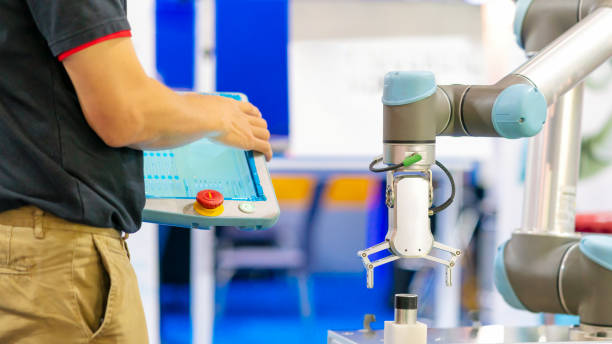Step into the world of industrial automation’s future! The emergence of collaborative robotics specifically by the robust cobot arm, is revolutionizing the presence of robots across different sectors. These previously limited and solitary machines have become instrumental in reshaping work dynamics by working alongside humans with utmost safety and productivity. Meet the cobot arms that pave the way for seamless human-machine collaboration.
What is a Cobot Arm?
- Cobotics, also known as collaborative robotics involves robots working alongside humans to enhance manufacturing processes. The cobot arm, an innovative robotic manipulator with multiple joints and end-effectors, is utilized with precision and safety in various industrial applications.
These arms, equipped with advanced sensors, can detect force or pressure, ensuring secure operation without causing harm. Programming them is seamless through intuitive interfaces or physical manipulation. Cobot arms excel in tasks such as pick-and-place, assembly, machine tending, packaging, and quality control across diverse industries.
A key advantage of cobot arms is their role in boosting productivity. By automating tasks alongside human operators, they enhance efficiency on the shop floor. Additionally, cobot arms improve product quality by minimizing errors linked to manual labor, resulting in reduced waste, lower costs, and heightened customer satisfaction.
Continuous technological advancements are progressively overcoming limitations like varying payload capacities. Safety remains a top priority, with built-in sensors enabling cobot arms to promptly detect unexpected contact with humans, leading to the immediate cessation or deceleration of movements to mitigate accident risks.
Advantages of Using a Cobot Arm in Industry
Using a Cobot (Collaborative Robot) Arm in the industry offers several advantages, contributing to enhanced efficiency, safety, and flexibility. Here are the key benefits:
-
Precision and Flexibility
Precision and flexibility in industrial automation denote the system’s capacity for accurate task execution and adaptability to diverse operations or changing conditions without compromising performance. Precision ensures exactness in task completion, while flexibility allows the system to handle various tasks efficiently. These qualities are important for optimizing efficiency and meeting dynamic manufacturing requirements.
-
Safety at the Forefront
Advanced sensors integrated into cobot arms prioritize safety by detecting force or pressure, ensuring secure operations even near human workers.
-
Ease of Programming
Cobot arms can be effortlessly programmed by operators with varying technical expertise through intuitive interfaces or physical manipulation.
-
Boosted Productivity
Automating tasks alongside humans significantly amplifies productivity, leading to improved efficiency, streamlined workflows, and enhanced overall output on the shop floor.
-
Quality Assurance
Unrivaled precision reduces errors typically associated with manual labor, resulting in heightened product quality, minimized waste, reduced costs, and increased customer satisfaction.
-
Overcoming Limitations
Continuous technological advancements progressively diminish limitations, including varying payload capacities, rendering cobots more capable and versatile.
Cobot arms embody the future of manufacturing, blending human ingenuity and robotic capabilities for unprecedented innovation, efficiency, and safety. The transformative potential of cobotics continually pushes technological boundaries, envisioning a future where collaboration knows no bounds.
Applications of Cobot Arms in Different Industries
Step into the dynamic world of cobot arms, where adaptability and versatility redefine industries! Join the journey as these robotic marvels influence various fields:
-
Manufacturing
Witness cobot arms in action, mastering assembly tasks with finesse—picking, placing, screwing, gluing, and conducting flawless quality inspections. They’re not just streamlining repetitive tasks but revolutionizing efficiency while slashing errors.
-
Automotive
In automotive applications, cobot arms excel in welding, painting, and material handling, serving as unsung heroes. Their precision and unwavering consistency contribute to increased productivity while upholding the highest quality standards.
-
Healthcare
In healthcare, cobots take center stage, assisting surgeons with precision and delicacy. Picture them holding instruments, executing intricate movements with minimal invasiveness, and supporting medication delivery systems. The result? Elevated efficiency and improved patient outcomes.
-
Agriculture
Venture into agriculture, where cobot arms transform harvesting into a seamless, automated symphony. Delicately picking fruits and vegetables, these robots minimize damage, streamline operations, and optimize yields.
-
Small Businesses
Even in smaller enterprises, from cozy food service establishments to bustling retail stores, cobot arms prove to be invaluable allies. Witness them expertly packing items into containers, stocking shelves with precision, and boosting productivity.
As we ride the wave of technological advancement, the potential applications for cobot arms seem boundless. From revolutionizing traditional industries to spearheading innovation in emerging sectors, these robotic assistants are set to become the heartbeat of the future of work. Get ready to be amazed by the transformative influence of cobotic wonders!
Challenges and Limitations of Cobot Arms
While cobot arms undeniably offer transformative benefits, it’s important to recognize the challenges and limitations they pose:
-
Cost
Investment hurdles! The substantial initial cost associated with cobot arms, especially for small businesses with limited budgets, may impede widespread adoption despite their long-term benefits.
-
Complexity of Implementation
Intricate integration! Bringing cobot arms into existing workflows demands meticulous planning and may involve intricate programming. Adequately training employees to operate and collaborate effectively with these robots requires dedicated time and resources.
-
Payload Capacity
Heavy load hurdles! Despite advancements, cobot arms still grapple with limitations in handling substantial loads. This constraint may restrict their suitability for tasks or industries requiring robust lifting capabilities.
-
Task Suitability
Not a perfect fit! Certain tasks may not align with cobot arms due to precision requirements or delicate handling needs. In such cases, alternative automation solutions or human intervention may prove more appropriate.
-
Safety Concerns
Safe collaboration! While collaborative robots are designed for secure coexistence with humans, ensuring proper risk assessments and adherence to safety standards remains important . Addressing safety concerns stands as an important aspect of implementing cobot arms in industrial settings.
To overcome these challenges, ongoing research and development efforts focus on enhancing cobot capabilities. This includes improving strength and dexterity, advancing artificial intelligence algorithms for better decision-making, and developing more intuitive programming interfaces.
Safety Features and Standards for Collaborative Robotics
Discover key safety aspects and standards governing their use in the field of collaborative robotics. Cobot arms prioritize worker well-being with a suite of features.
-
Force Sensing
Feel the safety! Built-in sensors on cobots detect external forces, allowing them to swiftly identify contact with a person or object. This capability enables cobot arms to promptly cease or adjust their movements, preventing accidents and ensuring secure collaboration with humans.
-
Collision Detection
Ready for impact! Cobot arms feature collision detection systems that automatically halt or adjust their trajectory upon encountering an obstacle. Swift responses to potential collisions mitigate the risk of injury and damage in dynamic industrial environments.
-
Ergonomic Design
Smooth operators! Many cobot arms sport smooth surfaces and rounded edges to minimize the risk of accidental cuts or bruises during operation. Additionally, protective covers may be integrated around important components to further enhance worker safety.
-
Ongoing Advancements
Tech evolution! As technology advances, anticipate even more sophisticated safety features being integrated into future generations of cobot arms. These advancements will further enhance their ability to operate safely alongside humans in diverse industrial settings.
By prioritizing safety features and adhering to established standards, cobot arms can stand as reliable and safe companions in industries where humans closely collaborate with machines. With a commitment to continuous improvement and education, the forefront of safe and efficient industrial automation belongs to cobot arms.
Training and Implementation of Cobot Arms in the Workplace
Ensuring employee readiness is important for the effective integration of cobot arms into the workplace. Let’s delve into how companies can achieve this:
-
Technical Training
Elevate your team’s capabilities! Provide essential skills for operating, programming, and maintaining cobot arms. Empower your workforce to master user interfaces, comprehend programming software, and adhere to safety protocols, enabling them to handle tasks with ease.
-
Safety Protocols
Special emphasis should be placed on training employees in safety protocols tailored for working alongside cobot arms. This involves understanding how to collaborate safely with the robots, utilizing safety features like force-sensing technology, and knowing the appropriate response in case of emergencies.
-
Ongoing Support
Companies should provide continuous support to their staff, including regular refresher courses, access to online resources for troubleshooting, or a dedicated support team to address any technical challenges that may arise.
-
Implementation Planning
Before integrating cobot arms into existing workflows, companies should meticulously plan their implementation strategies. This includes assessing tasks suitable for automation, determining which processes will benefit most from cobot assistance, and planning the transition to minimize disruption to productivity.
-
Practical Considerations
Practical aspects like workspace layout, equipment compatibility, and integration with existing machinery should also be covered during training. Employees should comprehend how cobot arms fit into their workflow and how to optimize their usage for enhanced efficiency.
Companies can successfully integrate cobot arms into the workplace by providing comprehensive training programs and implementing effective strategies. With the necessary skills and knowledge employees can harness collaborative robotics to enhance efficiency, productivity, and innovation across various industries.
Conclusion
Collaborative robotics, particularly embodied by the powerful cobot arm, is reshaping various industries. These machines, once confined and seen as threats, now work alongside humans safely and efficiently, revolutionizing manufacturing and healthcare. Despite challenges, ongoing advancements in sensors and AI continually enhance cobot capabilities.
To fully benefit, proper training and implementation strategies must prioritize workforce education and safety protocols. Adhering to standards and conducting risk assessments are important for a secure working environment. Looking ahead, advanced sensing technologies promise increased autonomy and refined human-robot interaction, extending cobot applications beyond industrial settings. This persistent innovation signifies a significant leap in automation technology, transforming workplaces and enhancing daily life.




